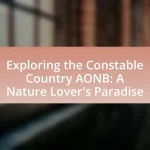Constable Country is characterized by its unique ecosystems, which include wetlands, woodlands, and agricultural landscapes that support a diverse range of flora and fauna. These ecosystems are distinct due to their combination of habitats, historical land use practices, and geographical features that influence local biodiversity. The article explores the importance of biodiversity in maintaining ecological balance, the threats these ecosystems face from human activities and climate change, and the conservation efforts in place to protect them. Additionally, it highlights the recreational opportunities available and the ways local communities can engage in preserving these vital environments.

What are the Unique Ecosystems of Constable Country?
The unique ecosystems of Constable Country include wetlands, woodlands, and agricultural landscapes. These ecosystems support diverse flora and fauna, with wetlands providing habitats for various bird species and aquatic life, while woodlands are home to ancient trees and a variety of wildlife. The agricultural landscapes contribute to the region’s biodiversity by integrating traditional farming practices that promote ecological balance. The presence of these ecosystems is vital for maintaining the area’s natural heritage and supporting local wildlife populations.
How do these ecosystems differ from other regions?
The ecosystems of Constable Country differ from other regions primarily due to their unique combination of wetland habitats, diverse flora and fauna, and historical land use practices. These ecosystems support a variety of species that are specifically adapted to the local conditions, such as the presence of marshes and rivers, which are less common in many other regions. For instance, the area is known for its rich biodiversity, including rare bird species like the bittern, which thrive in the reed beds that characterize the wetlands. Additionally, the traditional agricultural practices in Constable Country, such as grazing and haymaking, have shaped the landscape and contributed to the ecological diversity, distinguishing it from more industrialized or urbanized regions.
What specific characteristics define the ecosystems in Constable Country?
The ecosystems in Constable Country are characterized by a diverse range of habitats, including wetlands, woodlands, and agricultural landscapes. These habitats support a variety of flora and fauna, with notable species such as the marsh harrier and various wildflowers. The region’s unique geology, comprising clay and alluvial soils, contributes to its rich biodiversity. Additionally, the presence of rivers and streams enhances the ecological complexity, providing essential water resources and supporting aquatic life. The combination of these factors creates a vibrant ecosystem that is both ecologically significant and culturally important, as evidenced by its designation as an Area of Outstanding Natural Beauty.
How do geographical features influence these ecosystems?
Geographical features significantly influence the ecosystems of Constable Country by shaping climate, soil types, and water availability. For instance, the presence of rivers and wetlands creates diverse habitats that support various plant and animal species, while the surrounding hills and valleys affect local weather patterns, leading to microclimates. Additionally, the soil composition, influenced by the underlying geology, determines the types of vegetation that can thrive in the area. Studies have shown that these interactions contribute to the rich biodiversity found in Constable Country, making it a unique ecological region.
Why is biodiversity important in Constable Country?
Biodiversity is important in Constable Country because it enhances ecosystem resilience, supports a variety of species, and contributes to the overall health of the environment. The diverse habitats in Constable Country, including wetlands, woodlands, and agricultural landscapes, provide essential resources for numerous plant and animal species, which in turn maintain ecological balance. Studies indicate that areas with higher biodiversity are better equipped to withstand environmental changes and disturbances, such as climate change and habitat loss, thereby ensuring the sustainability of the region’s unique ecosystems.
What species are endemic to Constable Country?
The species endemic to Constable Country include the Constable Country butterfly and the Suffolk marsh harrier. These species are specifically adapted to the unique habitats found in this region, such as the coastal marshes and heathlands. The Constable Country butterfly, for instance, thrives in the local flora, which provides essential resources for its lifecycle. The Suffolk marsh harrier, a bird of prey, relies on the wetlands for nesting and hunting, showcasing the ecological significance of Constable Country’s environment.
How does biodiversity contribute to the health of these ecosystems?
Biodiversity significantly contributes to the health of ecosystems by enhancing resilience, stability, and productivity. Diverse species fulfill various ecological roles, such as pollination, nutrient cycling, and pest control, which are essential for maintaining ecosystem functions. For instance, ecosystems with a higher variety of plant species can better withstand environmental stressors like drought or disease, as different species may have varying tolerances and adaptations. Research indicates that ecosystems with greater biodiversity are more productive and can recover more quickly from disturbances, as seen in studies showing that diverse coral reefs are more resilient to climate change impacts compared to monoculture reefs. Thus, biodiversity is crucial for sustaining the ecological balance and overall health of ecosystems.
What threats do the ecosystems of Constable Country face?
The ecosystems of Constable Country face several significant threats, including habitat loss, pollution, and climate change. Habitat loss primarily results from agricultural expansion and urban development, which disrupts local flora and fauna. Pollution from agricultural runoff and industrial activities contaminates water sources, adversely affecting aquatic ecosystems. Additionally, climate change leads to altered weather patterns, impacting species distribution and ecosystem health. These threats collectively jeopardize the biodiversity and ecological integrity of Constable Country’s unique environments.
How do human activities impact these ecosystems?
Human activities significantly impact the ecosystems of Constable Country through pollution, habitat destruction, and climate change. Pollution from agricultural runoff introduces harmful chemicals into waterways, affecting aquatic life and plant health. Habitat destruction occurs due to urban development and land conversion for agriculture, leading to loss of biodiversity and disruption of ecological balance. Additionally, climate change, driven by human emissions, alters temperature and precipitation patterns, further stressing these ecosystems. For instance, studies indicate that increased temperatures can lead to shifts in species distribution and the timing of biological events, such as flowering and migration, which can disrupt food webs and ecological interactions.
What natural challenges affect the ecosystems in Constable Country?
Natural challenges affecting the ecosystems in Constable Country include flooding, erosion, and climate change. Flooding can disrupt habitats and lead to loss of biodiversity, while erosion affects soil quality and stability, impacting plant and animal life. Climate change contributes to altered weather patterns, which can result in shifts in species distribution and the timing of natural events, such as flowering and migration. These factors collectively threaten the ecological balance and health of Constable Country’s unique ecosystems.
How can we protect the unique ecosystems of Constable Country?
To protect the unique ecosystems of Constable Country, implementing conservation strategies is essential. These strategies include establishing protected areas to preserve habitats, promoting sustainable land use practices to minimize environmental impact, and engaging local communities in conservation efforts to foster stewardship. Research indicates that protected areas can significantly enhance biodiversity, as seen in studies showing that regions with conservation measures experience a 30% increase in species richness. Additionally, sustainable practices, such as agroecology, have been proven to reduce habitat degradation while supporting local economies. Engaging communities ensures that conservation efforts are culturally relevant and effective, as evidenced by successful initiatives in similar ecosystems worldwide.
What conservation efforts are currently in place?
Conservation efforts currently in place in Constable Country include habitat restoration, species protection programs, and community engagement initiatives. These efforts aim to preserve the unique ecosystems by restoring native vegetation, protecting endangered species such as the European eel, and involving local communities in conservation activities. For instance, the National Trust and local conservation groups collaborate on projects that enhance biodiversity and promote sustainable land use practices. These initiatives are supported by research indicating that habitat restoration can significantly improve ecosystem health and resilience.
How can local communities contribute to ecosystem preservation?
Local communities can contribute to ecosystem preservation by engaging in sustainable practices, such as community-led conservation initiatives and habitat restoration projects. These efforts often involve local residents in monitoring biodiversity, reducing pollution, and promoting native species, which directly benefits the local ecosystem. For instance, studies have shown that community-managed areas can lead to a 30% increase in biodiversity compared to unmanaged regions. Additionally, local knowledge and cultural practices can enhance conservation strategies, making them more effective and tailored to specific ecosystems.
What role does climate play in Constable Country’s ecosystems?
Climate significantly influences Constable Country’s ecosystems by determining temperature, precipitation, and seasonal variations that affect biodiversity and habitat conditions. The temperate maritime climate, characterized by mild winters and cool summers, supports a diverse range of flora and fauna, including wetlands, grasslands, and woodlands. This climate fosters rich soil conditions, which in turn sustain various plant species, contributing to the overall ecological balance. Additionally, the regular rainfall patterns help maintain water levels in rivers and lakes, crucial for aquatic ecosystems. The interplay of these climatic factors ensures the resilience and adaptability of the ecosystems within Constable Country.
How does climate variability affect the flora and fauna?
Climate variability significantly impacts flora and fauna by altering their habitats, reproductive cycles, and food availability. Changes in temperature and precipitation patterns can lead to shifts in plant growth, affecting the entire food web. For instance, studies have shown that increased temperatures can cause earlier flowering in plants, which may not align with the life cycles of pollinators, leading to reduced reproduction rates in both plants and pollinators. Additionally, climate variability can result in habitat loss, as species may struggle to adapt to rapid changes, leading to declines in biodiversity. Research indicates that ecosystems with high climate variability, such as those in Constable Country, are particularly vulnerable, as species may not be able to migrate or adapt quickly enough to survive.
What are the seasonal changes observed in these ecosystems?
Seasonal changes in the ecosystems of Constable Country include variations in flora and fauna, temperature, and precipitation patterns. During spring, blooming wildflowers and increased animal activity are prominent as temperatures rise and days lengthen. In summer, ecosystems experience peak biodiversity, with lush vegetation and a variety of species thriving due to warmer temperatures and abundant rainfall. Autumn brings a shift as leaves change color and many species prepare for winter, leading to a decrease in animal activity and plant growth. Winter results in colder temperatures, reduced daylight, and dormancy in many plant species, while some animals hibernate or migrate. These seasonal transitions are critical for maintaining ecological balance and biodiversity in Constable Country.
How do climate change impacts manifest in Constable Country?
Climate change impacts in Constable Country manifest primarily through altered weather patterns, increased flooding, and shifts in biodiversity. These changes have led to more frequent and intense rainfall events, which can overwhelm local ecosystems and agricultural practices. For instance, the Environment Agency reported that the region has experienced a 20% increase in rainfall over the past few decades, contributing to soil erosion and habitat loss. Additionally, rising temperatures have affected species distribution, with some native plants and animals struggling to adapt, leading to a decline in local biodiversity. This evidence underscores the significant and ongoing effects of climate change on Constable Country’s unique ecosystems.
What adaptations do species in Constable Country exhibit?
Species in Constable Country exhibit adaptations such as drought resistance, camouflage, and specialized feeding strategies. These adaptations enable them to thrive in the diverse habitats found in the region, which includes wetlands, woodlands, and grasslands. For instance, many plant species have developed deep root systems to access water during dry periods, while animals like the European rabbit utilize their fur coloration to blend into the landscape, enhancing their survival against predators. Additionally, certain bird species have adapted their beak shapes to exploit specific food sources available in their environment, demonstrating a clear link between their physical traits and ecological niches.
How do plants adapt to the local climate and soil conditions?
Plants adapt to local climate and soil conditions through various physiological and morphological changes. For instance, in arid climates, plants may develop deep root systems to access groundwater, while in nutrient-poor soils, they might form symbiotic relationships with mycorrhizal fungi to enhance nutrient uptake. Additionally, some plants exhibit drought resistance by developing waxy leaves to reduce water loss or by altering their photosynthetic pathways to minimize water usage. These adaptations are crucial for survival and growth in specific environments, as evidenced by the presence of xerophytes in dry regions and hydrophytes in wetland areas.
What behavioral adaptations are seen in wildlife?
Wildlife exhibits various behavioral adaptations that enhance survival and reproduction in their specific environments. For instance, migratory patterns in birds, such as the Arctic Tern, demonstrate adaptation to seasonal changes, allowing them to exploit different food sources and breeding grounds. Additionally, many species, like wolves, exhibit pack behavior, which facilitates hunting efficiency and social structure, improving their chances of survival. These adaptations are crucial for maintaining ecological balance and ensuring species resilience in changing habitats.
What are the key features of Constable Country’s landscapes?
The key features of Constable Country’s landscapes include rolling hills, lush meadows, and picturesque rivers. These elements create a quintessential English rural scene that inspired the artist John Constable in the early 19th century. The area is characterized by its diverse flora and fauna, with ancient woodlands and wetlands contributing to its ecological richness. Additionally, the presence of historical landmarks, such as churches and farms, enhances the cultural significance of the landscape, reflecting the harmony between nature and human activity.
How do different habitats coexist within Constable Country?
Different habitats coexist within Constable Country through a combination of geographical diversity, ecological interactions, and conservation efforts. The region features a mosaic of landscapes, including wetlands, woodlands, and agricultural fields, which support various species and ecological processes. For instance, the wetlands provide essential breeding grounds for amphibians and waterfowl, while woodlands offer shelter and food for numerous bird species. Additionally, sustainable farming practices in the agricultural areas help maintain biodiversity by preserving hedgerows and field margins that serve as wildlife corridors. These interconnected habitats enhance resilience and promote a balanced ecosystem, demonstrating the importance of habitat diversity in maintaining ecological health.
What types of habitats can be found in Constable Country?
Constable Country features a variety of habitats, including wetlands, woodlands, grasslands, and riverine environments. These habitats support diverse flora and fauna, with wetlands providing crucial breeding grounds for amphibians and birds, while woodlands offer shelter for various mammals and insects. The presence of the River Stour enhances the ecological richness, creating a dynamic environment that sustains numerous species.
How do these habitats support various species?
Habitats in Constable Country support various species by providing essential resources such as food, shelter, and breeding grounds. These ecosystems, including wetlands, woodlands, and grasslands, create diverse microhabitats that cater to the specific needs of different organisms. For instance, wetlands offer abundant aquatic plants and insects, which are crucial for birds and amphibians, while woodlands provide cover and nesting sites for mammals and birds. The presence of a variety of plant species ensures a stable food supply, which is vital for herbivores and, consequently, the predators that rely on them. Studies have shown that areas with high biodiversity, like those in Constable Country, can sustain more species due to the availability of multiple niches and resources, enhancing ecosystem resilience and stability.
What recreational opportunities do these ecosystems provide?
These ecosystems provide a variety of recreational opportunities, including hiking, birdwatching, fishing, and photography. Hiking trails allow visitors to explore the diverse landscapes, while birdwatching spots attract enthusiasts due to the rich avian biodiversity. Fishing is popular in local rivers and lakes, which are home to various fish species. Additionally, the picturesque scenery offers excellent photography opportunities, making it a favored destination for nature photographers.
How can visitors engage with the natural environment responsibly?
Visitors can engage with the natural environment responsibly by adhering to the principles of Leave No Trace, which emphasizes minimizing impact on ecosystems. This includes staying on designated trails to protect native vegetation, properly disposing of waste to prevent pollution, and respecting wildlife by observing from a distance without disturbing their habitats. Research indicates that following these guidelines helps preserve biodiversity and maintain the integrity of ecosystems, as evidenced by studies showing reduced erosion and improved wildlife health in areas where visitors practice responsible engagement.
What are the best practices for enjoying Constable Country’s ecosystems?
To enjoy Constable Country’s ecosystems, visitors should prioritize responsible behavior, such as staying on designated paths to protect native flora and fauna. This practice minimizes habitat disruption and preserves the area’s biodiversity, which includes various species of plants and animals unique to the region. Additionally, visitors should avoid littering and use eco-friendly products to reduce pollution, as studies show that waste can significantly harm local wildlife and ecosystems. Engaging in guided tours led by knowledgeable local experts can also enhance the experience, providing insights into the ecological significance of the area while ensuring that visitors adhere to conservation principles.
What are the best ways to learn about Constable Country’s ecosystems?
The best ways to learn about Constable Country’s ecosystems include visiting local nature reserves, participating in guided walks, and engaging with educational programs offered by conservation organizations. Nature reserves such as Flatford Wildlife Garden provide firsthand experiences of the diverse habitats, while guided walks led by knowledgeable rangers offer insights into the flora and fauna specific to the area. Additionally, organizations like the National Trust and local wildlife groups often conduct workshops and talks that delve into the ecological significance of Constable Country, enhancing understanding through expert-led discussions and interactive learning.
What resources are available for education and exploration?
Educational resources for exploring the unique ecosystems of Constable Country include guided nature walks, educational workshops, and online platforms that provide information about local flora and fauna. For instance, the National Trust offers organized events and activities that focus on the area’s biodiversity, allowing participants to learn directly from experts. Additionally, local schools and community organizations often collaborate with environmental groups to create programs that enhance understanding of the region’s ecosystems. Online resources, such as the UK government’s biodiversity website, provide comprehensive data and educational materials about the ecological significance of Constable Country, supporting both formal and informal learning.
How can guided tours enhance the understanding of these ecosystems?
Guided tours enhance the understanding of ecosystems by providing expert insights and contextual information that deepen visitors’ knowledge. These tours often include trained naturalists or ecologists who explain the intricate relationships within the ecosystem, such as species interactions and environmental processes. For example, in Constable Country, guided tours can highlight the significance of local flora and fauna, illustrating how they contribute to the overall health of the ecosystem. Additionally, guided tours facilitate hands-on experiences, allowing participants to observe wildlife behaviors and habitat features firsthand, which reinforces learning through direct engagement. Studies show that experiential learning, such as that provided by guided tours, significantly improves retention of ecological knowledge compared to passive learning methods.


